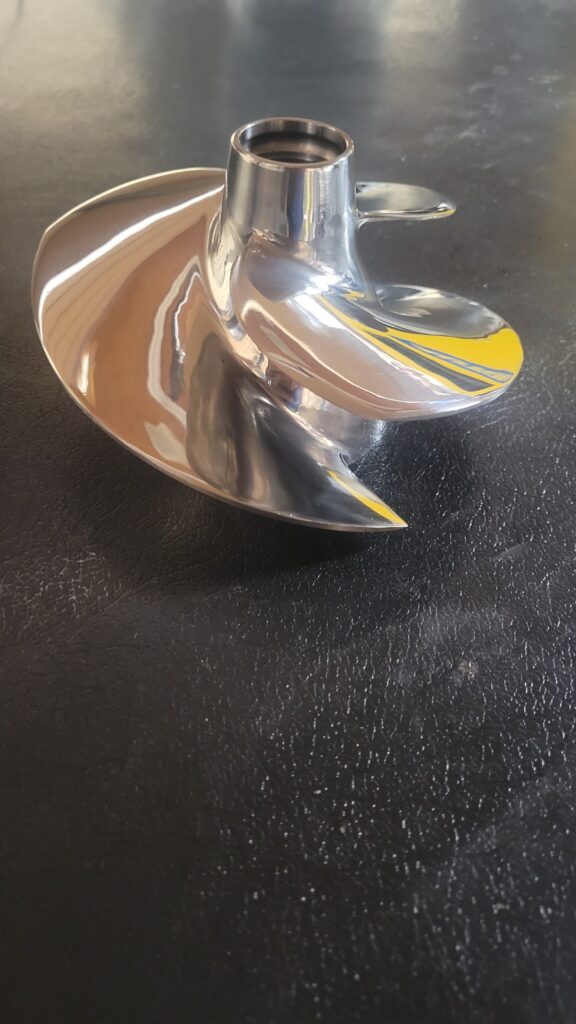Understanding Impellers and Their Importance
When it comes to optimizing your jet ski or jet boat’s performance, choosing the right impeller is crucial. The impeller is essentially the “heart” of your watercraft’s propulsion system. It draws water in and forces it out, generating the thrust that propels your craft forward. Picking the right one can make a noticeable difference in acceleration, top speed, and overall handling.
But before you decide which impeller is right for your jet ski or jet boat, it’s essential to understand impeller pitch, a key factor in impeller performance. In this post, we’ll break down what impeller pitch is and how to choose the best impeller based on your riding style and watercraft.
What Is Impeller Pitch?
Impeller pitch refers to the angle or twist of the blades on the impeller. It’s usually measured in degrees or as a number representing how far the impeller would theoretically move in one complete rotation if it were moving through a solid substance like a screw. For example, an impeller with a 13/19 pitch means the leading edge of the blades has a lower pitch (13 degrees), while the trailing edge has a higher pitch (19 degrees).
Here’s a quick breakdown of what impeller pitch means:
- Lower pitch numbers (e.g., 11/16): Impellers with lower pitches offer better acceleration but may reduce top-end speed. These are ideal for riders who prioritize quick takeoffs, such as those engaging in freestyle riding, sharp turns, or towing.
- Higher pitch numbers (e.g., 15/20): A higher pitch generally translates to higher top speeds but slower acceleration. These impellers are perfect for those who enjoy cruising at high speeds or racing.
- Dual pitch (e.g., 13/19): Many aftermarket impellers have two different pitches. The lower number indicates the pitch at the leading edge, and the higher number refers to the trailing edge. This combination helps balance acceleration with top-end speed, making it a versatile choice for mixed riding conditions.
Choosing the Right Impeller for Your Needs
Now that you know how impeller pitch works, you can select the right one based on your needs and riding style.
1. Recreational Riders: Focus on Acceleration and Handling
For recreational use, especially if you’re riding with friends, towing tubes, or cruising in areas where quick acceleration is essential, opt for an impeller with a lower pitch. This gives you a quick holeshot (initial takeoff power) and better low-end torque, making it easier to maneuver and get up to speed.
Best choice: Impellers with a pitch range of 11/16 or 12/17.
2. Freestyle Riders: Maximize Maneuverability
Freestyle riders who love wave jumping, performing tricks, and sharp turns will benefit from an impeller that offers strong acceleration and quick responses. You’ll want a lower-pitch impeller that helps you stay in control during sudden movements and allows for rapid speed changes.
Best choice: A 10/16 or 11/17 impeller is ideal for this kind of agility and maneuverability.
3. Speed Enthusiasts: Prioritize Top-End Speed
If you’re into racing or just love to hit the highest speeds possible, a high-pitch impeller is what you need. These impellers are designed for maximum efficiency at high RPMs, allowing you to reach higher top speeds once you’ve built up momentum. However, you might sacrifice some acceleration to get there.
Best choice: Look for an impeller with a 14/20 or 15/21 pitch for high-speed cruising.
4. Offshore and Long-Distance Riders: Balance Between Speed and Efficiency
If you ride your jet ski or jet boat over long distances or in open water, you’ll want an impeller that balances acceleration with speed. A dual-pitch impeller can provide the best of both worlds, giving you decent takeoff speed while maintaining solid performance at higher RPMs for cruising.
Best choice: Opt for a 13/18 or 14/19 impeller for this balance.
Additional Factors to Consider
- Engine Modifications: If you’ve made performance upgrades to your jet ski or jet boat—such as installing an aftermarket exhaust, high-flow air intake, or ECU tuning—you may need a more aggressive impeller to match the increased horsepower.
- Water Conditions: The kind of water you typically ride in also plays a role. Calm, flat water may allow you to take advantage of a higher-pitch impeller for speed, whereas choppier conditions may require more acceleration and control from a lower-pitch impeller.
- Impeller Material: Most impellers are made of stainless steel or aluminum. Stainless steel impellers are more durable and resistant to wear, especially in sandy or debris-filled waters, making them a better investment for long-term use.
Aftermarket vs. OEM Impellers
While OEM (Original Equipment Manufacturer) impellers are a safe bet, they’re often tuned for general performance rather than specialized riding styles. Aftermarket impellers from brands like Solas or Skat-Trak offer custom pitches and materials that can better suit your performance needs.
Conclusion: The Right Impeller for Your Watercraft
Choosing the right impeller for your jet ski or jet boat depends on how you use your watercraft. Whether you’re a recreational rider, a freestyle enthusiast, or a speed demon, selecting an impeller with the right pitch can significantly enhance your experience on the water.
Remember, it’s all about balancing your need for acceleration, top speed, and handling to match your specific riding conditions. So take your time to understand what pitch best suits your style and watercraft setup, and you’ll be gliding through the water with optimized performance in no time!

